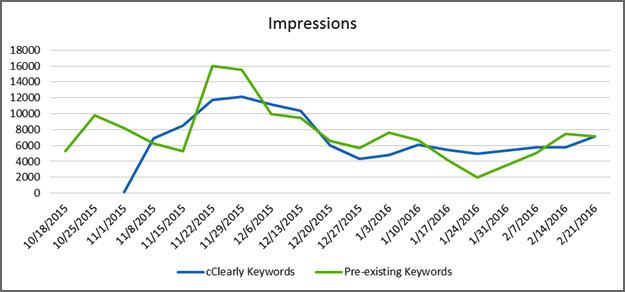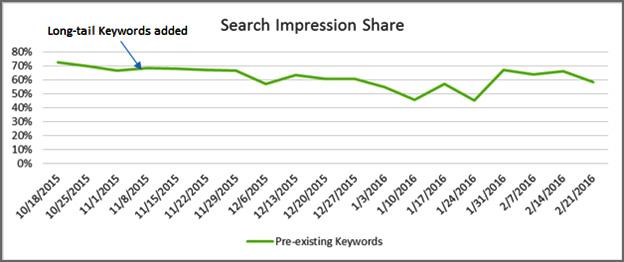Part 3 of this series examines whether the impressions and clicks generated by long-tail keywords are incremental to the impressions and clicks already being driven by the pre-existing keywords, or
whether they are at the expense of the pre-existing keywords. In other words, are you creating truly incremental volume or are you merely optimizing the impression volume that the pre-existing
keywords would have generated anyway?
Part 1 and
2 examined how bidding directly on long-tail keywords improved all
front-end metrics including click-through rates, cost per click and average position.
To evaluate this, I examine two factors: the change in impression pacing before and after the long-tail
keywords were added and the search impression share reported in AdWords Keyword Performance Report.
advertisement
advertisement
Impression Pacing
Measuring the daily or weekly pace of impressions before
and after long-tail keywords were added provides a good indication of whether the pre-existing keywords were able to maintain the same level of impressions after the long-tail keywords were added in,
or whether some of the impressions came at the expense of the pre-existing keywords.
This analysis can be a little tricky in a very seasonal business or product or if there were any special
sales or deals that ran during the period or other external factors that may affect daily search volume. One method I recommend to control for this is to create an A/B test scenario in which long-tail
keywords are added to some campaigns (our test group) while one group of campaigns remain as the control group and no long-tail keywords are added to them. I will also explain how the impression share
metric helps control for external factors.
The below example shows the client’s impression volume on their pre-existing keywords (in blue) starting Oct. 18. The line in green depicts the
impression volume of the long-tail keywords that were added in 3 weeks later on November 8. As can be seen from the graph, while there are small fluctuations in the weekly impression volume for the
pre-existing keywords, overall their volume remains fairly consistent and even seems to spike for a couple of weeks after the long-tail keywords were added in. The new long-tail keywords are
generating additional impression volume that seems to be fairly equal to the volume generated by the pre-existing keywords.
Therefore, the new long-tail keywords doubled the impression volume
overall because their improved click-through rates and conversion rates also contributed to a 400% increase in conversion volume. Part 4 will cover this in more detail.

Search Impression
Share
The Search Impression Share metric in the AdWords Keyword Performance Report indicates what percentage of impression the keyword received relative to the total number of impressions
available in the auctions that the keyword was eligible to participate in. Bing Ads also has a similar report. This metric is important because it
controls for any external changes to search volume.
The change in Search Impression Share of the pre-existing keywords after the long-tail keywords are added in is therefore a great way to
evaluate whether the impressions on the new long-tail keywords came at the expense of the pre-existing keywords. The below graph shows how the Search Impression Share remains fairly consistent at 70%
after the new long-tail keywords were added in on November 8th, indicating again that the impressions of the new long-tail keywords were fully incremental and not at the expense of the pre-existing
keywords.

Summary
Part 3 of this series examines how long-tail keywords can increase your overall share of voice. Part 4 will dive deeper into the back-end metrics to see how the addition of
the long-tail keywords impact conversion rates and cost per acquisition.